Fibromyalgia Awareness Through Digital Art
Some nights I watched my wife fold into herself, and I wished the world could see what I saw in her courage, not just her pain. Could digital art become a gentler language to show fibromyalgia’s truth so you feel seen, too?
Digital art translates fibromyalgia’s invisible symptoms into clear visuals that educate, validate, and build empathy. By combining anatomy illustration, silhouette art, and gentle motion, it raises awareness, reduces stigma, and creates shareable tools for support, care, advocacy, and training.
I’ve learned that images can hold what words drop. With female illustration art, figure poses, and human anatomy female references, we can map flare patterns, fatigue, and sensory overload without reducing you to a diagnosis. Medical art and silhouette art let us frame strength and struggle side by side, so your story isn’t edited down to “fine.”
When I sketch a quiet spine or a tender shoulder, drawing female body studies and body sketches, I’m not chasing perfection; I’m honoring reality. Figurative art woman pieces, digital portrait art, even soft figure sketching can turn the unseen into something understandable, something you can hand to a friend and say, “This is me.”
How Digital Art Makes the Invisible Visible?
When words fall short, digital art gives us a bridge between what a body feels and what the eye can understand. It lets us translate pain pathways, fatigue cycles, and sensory overwhelm into forms that invite care rather than doubt. It’s not decoration; it’s evidence and empathy stitched together.
With anatomy illustration, I can trace nerve tenderness the way a storm crosses a map. Female illustration art lets me honor soft strength without reducing a woman to symptoms. In silhouette art, a single contour can hold both endurance and grief.
Figure sketching helps me show micro-tension in shoulders and jaw where stress hides in plain sight. Using human anatomy art, I layer quiet markers of allodynia across the forearms and thighs. Body drawings women make space for nuance: stiffness, flares, and the hope tucked between them.
In digital portrait art, a gaze slightly off-camera tells you how much energy it costs to sit upright. Figure poses capture pacing breaks and curled-in rest, the honest intermissions of a day. A woman’s body sketch can carry dignity even when the spine bows to pain.
With medical art, I can render sleep debt as gentle shadows under the eyes. Body anatomy art turns “it hurts everywhere” into a readable legend. Beautiful art does not glamorize suffering; it respects it, and then it shows where compassion can land.
Female art reference poses keep proportions humane when fatigue shrinks a frame. Drawing female body studies reveal the way breath tightens when anxiety surges. Female artworks can place tenderness next to data, so care partners can see both at once.
Figure painting lets color do what language can’t: violet for nerve fire, pale blue for post-exertion emptiness. Female drawing base templates speed up iterations when a flare demands fewer clicks and more gentleness. Human anatomy female references protect accuracy without stealing warmth.
I remember the night my wife whispered that her body felt like static. I drew small constellation specks along her arms, and she nodded, as if finally mirrored. That is why I keep sketching: so your story is carried, not corrected.
When I hold her hand after a long day, I think of all of you trying to explain the unexplainable. I want the next section to give you practical ways to turn your truth into images that teach, comfort, and persuade. Here is what we will walk through next:
- Choose a gentle figure pose
- Map pain with color legends
- Mark fatigue with texture
- Show pacing and rest breaks
- Highlight sensory triggers
- Pair anatomy notes with feelings
- Create appointment-ready panels
- Add accessibility and consent

Choose a Gentle Figure Pose
Start with figure poses that feel safe and grounded, a seated stance, soft shoulders, and feet supported. In my sketches of my wife, a quiet three-quarter view lets me honor her dignity without forcing drama. With female illustration art and drawing female body studies, I keep joints relaxed and the neck long, so strain doesn’t steal the scene.
Using human anatomy female references, I map posture common in pain: a slight forward fold, hands over abdomen, and chin tucked for relief. Silhouette art helps me test contours first, then I build toward figure sketching with light strokes. Two or three poses are enough; this is awareness, not a fashion spread.
I ask, “Does this feel like you?” If she nods, we keep it. If not, I adjust until the body language tells the truth. A beautiful art is honest before it is pretty.
Map Pain with Color Legends
Color becomes a language: warm tones for nerve fire, cool tones for deep ache, neutrals for background stiffness. In the anatomy illustration, I set a legend upfront, so anyone glancing understands the code in a second. Body drawings women make this clear, no guessing, no minimizing.
On my wife’s arms, tiny embers mark allodynia; over her back, a slow tide of blue shows the heavy pull of fatigue. With digital portrait art, I blend edges so sensations feel gradual, not cartoonish. Figure painting lets color breathe, and transparency layers keep nuance.
I keep the scale gentle, 0 to 5 rather than 0 to 10, because precision beats exaggeration. Medical art is most persuasive when it looks measured, respectful, and repeatable. A legend invites empathy without a single plea.
Mark Fatigue with Texture
Fatigue is more than low energy; it’s a weight on every motion. I render it with texture rather than only hue. Soft grain across the thighs, cross-hatching near the shoulders, a vellum haze around the head, these cues read as heaviness.
In female body sketches, I add faint stippling along the calves to hint at delayed recovery after standing. Human anatomy art guides me to keep muscle landmarks accurate while the texture tells the story. With silhouette art, I feather the outer line to suggest tremor without drama.
When my wife says, “Climbing stairs felt like mud,” I use a muted pattern on the quads. Female artworks that carry lived detail earn trust. Texture becomes a witness, not a headline, and awareness lands softly but firmly.
Show Pacing and Rest Breaks
Pacing isn’t quitting; it’s strategy. I storyboard tiny panels: a short walk, a pause, a stretch, then a sit with supported elbows. Figure poses shift subtly panel to panel, modeling what kindness to the body looks like.
In woman body sketch studies, I include a timer icon and simple captions: “5 minutes on, 10 minutes off.” Anatomy illustration shows the spine decompressing when propped on cushions. Digital art excels at these micro-moments; you can copy a base and adjust hands, gaze, or seat height.
For my wife, these drawings became permission slips. They transformed guilt into a plan. Female artwork that normalizes rest breaks helps partners, teachers, and employers change expectations from judgment to collaboration.

Highlight Sensory Trigger Cues
Sensory overload is real. I use gentle icons for triggers: bright light, sharp noise, strong scent. In drawing female body scenes, I keep the environment minimal, then place small cues at the edges so the figure stays the focus.
With anatomy illustration, I add tiny radiating lines near the temples for migraine onset and a subtle halo around speakers for noise. Body anatomy art labels stay plain: “reduce glare,” “lower volume,” “unscented space.” This isn’t drama; it’s instruction.
For my wife, sunglasses indoors drew stares; now the sketch explains why. Female body reference keeps proportions kind while the scene does the teaching. Awareness grows when context is visible, not argued.
Pair Anatomy Notes with Feelings
Charts can feel cold; emotions alone can feel dismissed. I pair both. Under a shoulder diagram, I add a plain note “rotator cuff tenderness” and beside it, a human line “hurts to lift the kettle.”
In digital portrait art, a softened gaze pairs with a label: “post-exertional malaise.” Body drawings of women gain power when feelings have a seat at the table. Human anatomy female landmarks keep accuracy, while a small caption keeps humanity.
For my wife, this mix ended debates. People finally saw the system and the soul. Medical art that respects data and experience opens doors to care and keeps them open.
Create Appointment-Ready Panels
Clinics are busy. I design one-page panels that fit into a bag or phone. Figure sketching shows the current baseline pose, color legends map pain, and two lines summarize pacing. The goal is clarity in under thirty seconds.
Anatomy illustration marks specific sites, jaw, neck, sacrum, using standard terms. Silhouette art versions are great when privacy matters. I timestamp each panel so progress and setbacks are trackable over months.
When my wife hands a panel to a clinician, the room shifts from guesswork to a plan. Female illustration art becomes a bridge between lived reality and actionable steps. That’s awareness doing real work.
Add Accessibility and Consent
Accessibility begins with contrast, readable type, and alt text. I export high-contrast versions and a simple grayscale version for printers. Female drawing base layers help me create consistent sets quickly, so updates are easy during flares.
Consent is non-negotiable. We decide what to share publicly and what stays between us and the care team. I mask faces with silhouette art or crop to the torso when privacy is needed. File names stay neutral; metadata avoids personal details.
This respect is part of the message. Beautiful art female should never cost safety. Awareness rooted in consent teaches the world how to look and how to care.

Healing Narratives with Digital Art
There was a winter morning when my wife woke already tired, the kind of tired that settles in the bones. I sketched the shape of her breath, and the page finally listened.
In an anatomy illustration, I traced the small tremors along her forearms, not as defects but as signals asking for softer plans. Figure sketching let me keep her dignity while telling the truth about pacing.
Friends who once shrugged began to understand why a grocery trip can empty a day. A simple color legend turned chaos into a map. That map became a kindness that other people could carry.
I learned to pair labels with feelings, because “tender suboccipital muscles” lands deeper when it sits beside “hurts to wash my hair.” Female illustration art gave me a language quiet enough to hold grief without stealing hope.
With digital art, we could rehearse boundaries before appointments, practicing how to ask for rest breaks and lower lights. Silhouette studies kept privacy intact while the story stayed intact.
When I look at her asleep after a stormy day, I draw the softness of her jaw, and it keeps me from turning hardness toward the world. If you’re reading this and holding your own storm, I want these images to be a hand on your shoulder, proof that your invisible work is seen.

Final Word on Digital Art
What began as a private way to hold my wife’s hard days has become a language I trust. Pictures let us carry truth without noise. A quiet silhouette, a careful contour, a soft palette that breathes. Awareness lives in these choices, and so does respect. I am not trying to impress anyone. I am trying to see her clearly and help others see you with the same care.
I keep returning to simple practices because they work. I start with silhouette art to protect privacy and to find a posture that feels honest. I layer anatomy illustration only where it serves clarity. I use figure sketching for softness, then build toward figure painting when more depth is needed. I let color tell pain, and texture tell weight. When a scene needs words, I keep them plain and kind.
Female illustration art gives room for dignity. Figure poses that show pacing and rest teach without scolding. Body drawings women can hand to a teacher or manager and say. This is how the day actually moves. Human anatomy art marks the landmarks so that care teams have a common map. Medical art becomes a bridge instead of a wall when it travels with feeling.
I have learned to ask permission at every step. Some panels belong only in a clinic folder. Others can live on a phone for quick advocacy. When we publish, we remove identifiers, crop faces, and choose neutral file names. Consent protects the person before it protects the picture, and that order never changes.
My wife’s strength is not a pose. It is the way she keeps choosing gentleness when her body roars. I draw to remember that. I draw to show that the unseen work of pacing, resting, and starting again is not weakness. It is a skill. It is love. It deserves room in policy and in family habits.
If you make images, begin small. Choose one woman’s body sketch and add a quiet legend. Note a trigger and a boundary. Build a set you can update on flare days. Let the practice serve your life, not the other way around. Share only what feels safe. Keep a private folder for the rest.
For anyone supporting a partner, let the work be shared. Build appointment-ready panels, simple figure poses, and clear anatomy notes that a clinician can scan in half a minute. Keep versions for school, for work, for travel. Translate fatigue with texture, tenderness with light. When doubt shows up, you will have a map to offer. This is where digital art earns its name as care, not decoration, because it keeps stories while opening doors to understanding.
You are not hard to help. You were underdescribed. Use silhouette art, clear legends, and gentle figure sketching to make your truth readable in seconds. Share only what feels safe, keep the rest for care teams, and let each small panel teach the world how to show up for you, consistently and with respect.


About Me
Hi, I’m Lucjan! The reason why I decided to create this blog was my beautiful wife, who experienced a lot of pain in life, but also the lack of information about endometriosis and fibromyalgia for men…
READ MORE